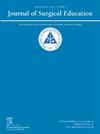Project Synapse: Efficacy of a Youth Outreach Program to Increase Diversity in Neurosurgery
IF 2.6
3区 医学
Q1 EDUCATION, SCIENTIFIC DISCIPLINES
引用次数: 0
Abstract
Background
There is a lack of diversity within neurosurgery; in 2019, only 12%, 4%, and 5% of neurosurgeons identify as female, black, and Latinx respectively. Project Synapse, a youth outreach initiative, aims to diversify the neurosurgical workforce by exposing youth from underrepresented minority (URM) backgrounds to neurosurgery. The purpose of this manuscript is to describe the outcomes of the first 2 years of Project Synapse.
Methods
Project Synapse hosted 7, 1-hour educational sessions; 457 middle and high school students from 17 Chicago schools participated. Prior to the workshop, students completed a survey containing 6-8 Likert-scale questions evaluating student attitudes towards medicine/neurosurgery and 5 true/false neuroscience knowledge questions. The survey was readministered postsession and scores were compared. Demographic information was captured.
Results
86% of participants identified as people of color, 14% as Hispanic or Latino and 63% as Female. Compared to pre-session, middle school students were significantly more likely to be interested in neuroscience (p = 0.042) and becoming a neurosurgeon (p = 0.004). High school students were significantly more likely to indicate interest in neuroscience (p = 0.018) and neurosurgery (p = 0.015), as well as familiarity with the career pathway to becoming a doctor (p = 0.018) and a neurosurgeon (p < 0.001). Student neuroscience knowledge significantly increased for both middle (p < 0.001) and high school (p < 0.001) students.
Conclusions
Physician-led neuroscience educational events can provide novel learning opportunities for URM students. Educational events for middle school students offer the potential to engage youth as their foundational career opinions are forming.
突触项目:提高神经外科多样性的青年外展计划的效果。
本文章由计算机程序翻译,如有差异,请以英文原文为准。
求助全文
约1分钟内获得全文
求助全文
来源期刊

Journal of Surgical Education
EDUCATION, SCIENTIFIC DISCIPLINES-SURGERY
CiteScore
5.60
自引率
10.30%
发文量
261
审稿时长
48 days
期刊介绍:
The Journal of Surgical Education (JSE) is dedicated to advancing the field of surgical education through original research. The journal publishes research articles in all surgical disciplines on topics relative to the education of surgical students, residents, and fellows, as well as practicing surgeons. Our readers look to JSE for timely, innovative research findings from the international surgical education community. As the official journal of the Association of Program Directors in Surgery (APDS), JSE publishes the proceedings of the annual APDS meeting held during Surgery Education Week.
 求助内容:
求助内容: 应助结果提醒方式:
应助结果提醒方式:


